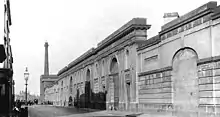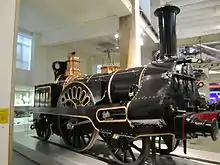 "Station, Grand Junction Railway, Vauxhall, Birmingham". Engraving by H. Harris, 1841. | |
| Overview | |
|---|---|
| Locale | Birmingham, Wolverhampton, Stafford, Crewe |
| Dates of operation | 4 July 1837–1846 |
| Predecessor | Warrington and Newton Railway |
| Successor | London and North Western Railway |
| Technical | |
| Track gauge | 4 ft 8+1⁄2 in (1,435 mm) |
| Length | 82 miles (132 km) |
The Grand Junction Railway (GJR) was an early railway company in the United Kingdom, which existed between 1833 and 1846 when it was amalgamated with other railways to form the London and North Western Railway. The line built by the company linking the Liverpool and Manchester Railway to Birmingham via Crewe, Stafford and Wolverhampton was the first trunk railway to be completed in England, and arguably the world's first long-distance railway with steam traction.[lower-roman 1]
The lines which comprised the GJR now form the central section of the West Coast Main Line.
History

The Grand Junction Railway Company was established in the second half of 1832 by the consolidation of two rival companies: the Birmingham and Liverpool Railway Company and the Liverpool and Birmingham Railway Company.[1] Authorised by Parliament on 6 May 1833[2][3] and designed by George Stephenson and Joseph Locke, the Grand Junction Railway opened for business on 4 July 1837,[4] running for 82 miles (132 km) from Birmingham through Wolverhampton (via Perry Barr and Bescot), Stafford, Crewe, and Warrington, then via the existing Warrington and Newton Railway to join the Liverpool and Manchester Railway at a triangular junction at Newton Junction. The GJR established its chief engineering works at Crewe, relocating there from Edge Hill, in Liverpool.[5]

It began operation with a temporary Birmingham terminus at Vauxhall,[6]: 12 The travelling post office where mail was sorted on a moving train was instituted on the Grand Junction Railway in January 1838. Using a converted horse-box, it was carried out at the suggestion of Frederick Karstadt, a General Post Office surveyor.[7] Karstadt's son was one of two mail clerks who did the sorting.[8]
When the London and Birmingham Railway opened on 17 September 1838, services were routed to and from Curzon Street station which it shared with the Grand Junction Railway, the platforms of which were adjacent, providing a link between Liverpool, Manchester and London. The route between Curzon Street railway station and Vauxhall primarily consisted of the Birmingham Viaduct. It consisted of 28 arches, each 31 feet (9.4 m) wide and 28 feet (8.5 m) tall and crossed the River Rea.[9] In October 1838, the Liverpool Mercury reported that
It is confidently expected, that after the ensuing winter is over, and the embankments on the London and Birmingham Line are well settled down, first class trains between Liverpool and Manchester and London will not occupy more than nine hours in the journey. This being accomplished, what further improvement could be desired between London and Lancashire?[10]

In 1840, the GJR absorbed the Chester and Crewe Railway[11] soon before it began operation. Considering itself as part of a grand railway network, the company encouraged the development of the North Union Railway which extended the tracks onward to Preston, and it also invested in the Lancaster and Carlisle Railway and the Caledonian Railway. In 1845, the GJR merged with the Liverpool and Manchester Railway, and consolidated its position by buying the North Union Railway in association with the Manchester and Leeds Railway.[12]
In 1841, the company appointed Captain Mark Huish as the secretary of the railway. Huish was ruthless in the development of the business and contributed significantly to the company's success.[13]
Profits
The GJR was very profitable, paying dividends of at least 10% from its beginning and having a final capital value of more than £5.75 million (equivalent to £592.39 million now)[14] when it merged with the London and Birmingham Railway and Manchester and Birmingham Railway companies[15] to become the London and North Western Railway in 1846, which in turn formed part of the London Midland and Scottish Railway in 1923.
Locomotives

One locomotive, Columbine, a 2-2-2 tender engine built in 1845 at Crewe Works, is preserved at the Science Museum.[16] Designed by Alexander Allan, it was the first of the GJR's standard 'Crewe-type' engines, with outside cylinders, and carried fleet number 49.[16] It was withdrawn from service in 1902 by the LNWR, carrying their number 1868.[16]
References
Notes
- ↑ The very first long distance railway had been the horse drawn line between České Budějovice in Bohemia, Linz, and Gmunden (Upper Austria).
- ↑ Jackman, W. T. (April 2014) [1916]. The Development of Transportation in Modern England. Cambridge University Press. p. 542. ISBN 9781107681828. Retrieved 13 July 2015.
- ↑ 3 & 4 Will. 4 c. xxxiv
- ↑ "The Bills which received the Royal assent on Monday were –". Morning Post. British Newspaper Archive. 8 May 1833. Retrieved 24 July 2016 – via British Newspaper Archive.
- ↑ "Opening of the Grand Junction Railway". London Evening Standard. British Newspaper Archive. 5 July 1837. Retrieved 24 July 2016 – via British Newspaper Archive.
- ↑ Reed, M.C. (1996). The London & North Western Railway. Penryn: Atlantic Transport Publishers. pp. 23–24. ISBN 0-906899-66-4.
- ↑ Drake, James (1838). Drake's Road Book of the Grand Junction Railway (1838). Moorland Reprints. ISBN 0903485257.
- ↑ White, John H. (1978). The American Railroad Passenger Car. Baltimore, MD: Johns Hopkins University Press. p. 473. ISBN 0801819652. OCLC 2798188.
- ↑ Johnson, Peter. (1985). The British Travelling Post Office. Surrey: Ian Allan Publishing. p. 13. ISBN 0-7110-1459-0.
- ↑ Osborne & Osborne 1838, pp. 108–9.
- ↑ "Grand Junction Railway". Liverpool Mercury. British Newspaper Archive. 26 October 1838. Retrieved 24 July 2016 – via British Newspaper Archive.
- ↑ "Grand Junction Railway". Wolverhampton Chronicle and Staffordshire Advertiser. British Newspaper Archive. 12 February 1840. Retrieved 24 July 2016 – via British Newspaper Archive.
- ↑ Reed 1996, pp. 21–22
- ↑ Mark Huish and the London and North Western Railway, A Study of Management – Dr Terry Gourvish (Leicester UP, 1972);
- ↑ UK Retail Price Index inflation figures are based on data from Clark, Gregory (2017). "The Annual RPI and Average Earnings for Britain, 1209 to Present (New Series)". MeasuringWorth. Retrieved 11 June 2022.
- ↑ "Grand Junction Railway". Gore’s Liverpool and General Advertiser. British Newspaper Archive. 19 February 1846. Retrieved 24 July 2016 – via British Newspaper Archive.
- 1 2 3 "Grand Junction Railway locomotive 'Columbine'". Science Museum. Retrieved 22 January 2019.
Sources
- Webster, Norman W. (1972). Britain's First Trunk Line – the Grand Junction Railway. Bath: Adams & Dart. ISBN 0-239-00105-2.
- Osborne, E.C.; Osborne, W. (1838). Osborne's guide to the Grand Junction, or Birmingham, Liverpool and Manchester Railway (2 ed.). Birmingham & London: E.C. & W. Osbourne —Simkin, Marshall, and Co. — Darton & Clark. OCLC 437315296.
Further reading
- Arthur Freeling (1837), The Grand Junction Railway Companion to Liverpool, Manchester, and Birmingham, Wikidata Q106779240
- Whishaw, Francis (1842). The Railways of Great Britain and Ireland Practically Described and Illustrated (2nd ed.). London: John Weale. pp. 124–137. OCLC 833076248.
External links
- . Bradshaw's Guides – via Wikisource.